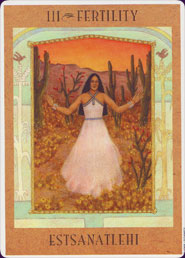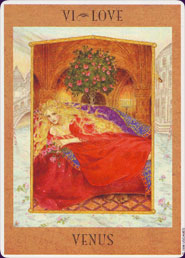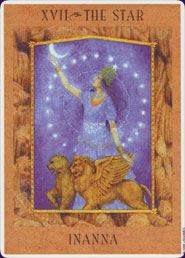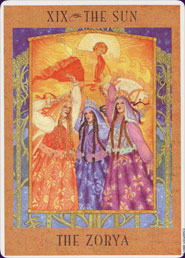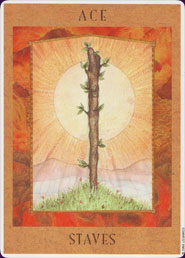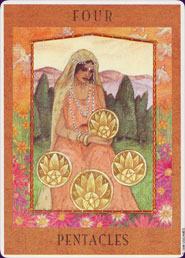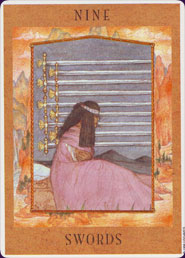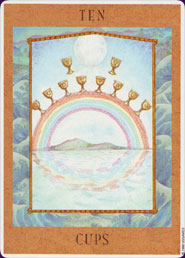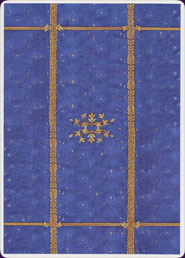Goddess Tarot Deck Review
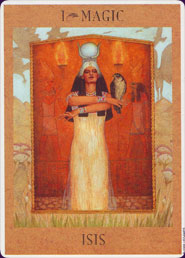
One of my favourites, the Goddess Tarot deck incorporates Goddess images and lore from many cultures into a very beautiful and well-made Tarot deck of 78 cards.
Deck Type: Tarot Deck Cards: 78
Creators: Kris Waldherr
Publisher: US Games 1997
Retailers
See Price at Amazon.comSee Price at Amazon.co.uk
See Price at Amazon.ca
Goddess Tarot Review by Star
This Tarot deck is one of the best I've seen. Very detailed and eye catching. My favorite card is the Love card, represented by the Roman Goddess Venus. The golden haired courtesan is lounging on a couch, pink roses cling to her hair as she stares at you with desire flaming in her eyes. She's draped in the finest flaming red gown. The ornately detailed room behind her seems to come to life during a reading. I even like the puppy asleep under the couch! The background behind the bordered goddess displays a lovely golden aged Venice.Another one of the Major Arcana cards I like is Movement, depicted as the British horse Goddess Rhiannon. She rides a beautiful but unearthly white horse, sidesaddle, through a forest. Behind the border are stately gold columns with doves perched atop them. You can feel a psychic bond with all of these women. The layers in each card reveal much more then you would initially expect.
The Goddess Tarot cards have been beautifully illustrated. Each major arcana has a different border that coincides with the Goddess on that card. Behind each border is a scene that depicts a way of life to the Goddess. It almost seems as if the backgrounds themselves have a story to tell. The Minor Arcana are also nicely illustrated, and each suit corresponds to a different Goddess. The suit of Swords is associated with the Magic card, which is depicted as the Egyptian fertility Goddess Isis. All sword cards have an ancient Egyptian feel to them. The tanned skinned women and men on these cards are accentuated wearing fine white linen. Lotus flowers decorate the background on many of these cards. The hilts of the swords are also a golden lotus flower design. Decorations such as these make each suit easily definable to the next.
The opposite side of the cards are a deep blue with embellished gold leafing, impressive yet understated. The care and detail that went into each card is richly rewarded with an almost visible link into the divine and spiritual world.
The cards have made deciphering the subconscious effortless. Friends I have done readings for are amazed at the accurateness of each card. I believe these to be a staple to any woman’s life.
I have to say I am extremely impressed with the high caliber of these cards. This deck is a wonderful way to bond through the centuries to a divine sisterhood of empowered women.
Goddess Tarot Review by Delia LaForte
As soon as I opened this deck, I knew it was something special. The cards felt magical and numinous in my hands. The Major Arcana is beautiful, evocative, relevant to women's lives. Each Major Arcana card is a goddess, and the particular goddesses are very well chosen. The names of the cards are often changed to more accurately reflect the meaning of the card. I found them extremely easy to read - the images spoke directly to me, and I only had to consult the booklet on a couple of cards to learn about an unfamiliar goddess. More knowledge of each goddess and her stories would, I'm sure, enhance the meanings further.
The images are much less frightening than those on the Rider-Waite deck, which draws so heavily on Christian imagery. The Hanged Man is replaced with Sacrifice and the image of Kwan Yin, the Bodhisattva of Compassion. This image is a lot easier to integrate into my life than the image of a man hung by his foot. Likewise, the Heirophant is replaced with Juno, who carries the meaning of Tradition. The largely hidden traditons of women, and the importance of those in our lives are made made accessible through this card. I found it particularly accurate and illuminating in a reading I did for myself after the recent death of my mother. At first I read the card as equivalent to the Hierophant, and the meaning made no sense. But when I really looked at the card, I suddenly realized that I was in the process of creating new traditions for my family that both drew on what my mother had taught me, and incorporated my own additions. It was inspiring to see this sense of living, changing traditions affirmed, rather than the patriarchal, institutionalized world of the Heirophant. I could never have gotten to that understanding with the Heirophant card.
This deck is beautifully illustrated, and in spite of drawing upon many cultures, has an artistic unity. The Minor Arcana draws heavily on the Rider-Waite deck, but each suit is built around a particular goddess. The choices seem very appropriate, and for anyone familiar with the Rider-Waite, are easy to read, as are the subtle changes in the cards which add to the meaning.
For women (or men) who celebrate the Goddess, or have
interest in the Goddess, this deck is truly a gift. It is
different that other decks, because it encourages us to find
the Goddess in ourselves, and through her, the
qualities needed to get through particular situations. This
deck teaches without being pedantic, and can be used
ceremonially. It subverts the patriarchal paradigm in favor of
a more matristic world view, and does so without
being trendy and politically correct, but by drawing on
a deep source.
Goddess Tarot Review by Bonnie Cehovet
Suits: Staves, Cups, Swords, Pentacles
Court Cards: Prince, Princess, King, Queen
I have been meaning to work with some of the Goddess based Tarot decks for a long time now. It seemed that this was to be part of my journey - but it was one that was never acted on. Now The Goddess Tarot has come into my life - at a time when life is being less than supportive, and a connection with feminine energy and intuition is much needed.
The physical formatting of the cards resembles that of the Ancestral Path Tarot. The deck is 3 1/2 " by 4 3/4 ", which is very easy to handle, even with small hands. The backs of the cards have a 1/4" white trim,then a blue backing with gold dotted through it. A gold line runs through the card horizontally, approximately one inch from the border on the top and the bottom. Two wider gold leaf images run vertically on each side of the card - approximately 1 1/2 " from the borders. In the center of the card is a series of gold leaves. The cards would appear the sam from the back, whether upright or reversed.
The Major Arcana cards have the same white border, followed by a beige border that acts as a frame for the central figure. The card number and title appear at the top, with the name of the appropriate goddess appearing at the bottom. The Major Arcana titles and the goddesses referenced are as follows:
0 Beginnings (Fool) - Tara
1 Magic (Magician) - Isis
2 Wisdom (High Priestess) - Sarasvati
3 Fertility (Empress) - Estsanatlehi
4 Power (Emperor) - Freyja
5 Tradition (Hierophant) - Juno
6 Love (Lovers) - Venus
7 Movement (Chariot) - Rhiannon
8 Justice (Justice) - Athena
9 Contemplation (The Hermit) - Chang
10 Fortune (Wheel of Fortune) - Lakshmi
11 Strength (Strength) - Oya
12 Sacrifice (The Hanged Man) - Kuan Yin
13 Transformation (Death) - Ukemochi
14 Balance (Temperance) - Yemana
15 Temptation (Devil) - Nyai Loro Kidul
16 Oppression (The Tower) - The Wawalak
17 The Star (The Star) - Innana
18 The Moon (The Moon) - Diana
19 The Sun (The Sun) - The Zorya
20 Judgment (Judgment) - Gwenhwyfar
21 The World (The World) - Gaia
The Minor Arcana (pips and court cards) are labled at the top with the title and across the bottom with the suit. The same format of white outer border and beige inner border is followed, with an inner border color coded to each suit (peach for Swords, red for Staves, blue for Cups and peach (again) for Pentacles).
There is also a goddess associated with each suit: Venus with Cups, Freyja with Staves, Isis with Swords and Lakshmi with Pentacles.
The card definitions are presented with a short bio of each goddess, the basic meaning of the card and the reversed or weakly aspected meaning. The latter drew my attention - as I do not see card meanings in a linear fashion. I see varying degrees of positive or negative influence, but not a strict "upright" or "reversed" relationship.
My favorite card in the deck - The World, represented by the goddess Gaia, Greek Goddess of the earth. Here we are reminded of the interconnectedness of all things. Of how living in balance and harmony has priority inour lives.
At the end of the book Ms Waldherr presents a variety of spreads to be used. We have the usual single card draw, a past/present/future layout and the Celtic Cross. (BTW - There is a very nice layout "cloth" that comes with this deck. It is paper - but is well done, using the Celtic Cross spread with nicely done definitions.) What intrigued me was the final spread presented - a 13 card relationship spread in the shape of a cross. I am off to play with that one right now myself!
The impetus behind the creation of this deck was to present a tool of empowerment that was connected with the feminine energy in life. This deck is certainly a "jumping off" place (or perhaps a "jumping in" place!) for studying the goddess images throughout time.
From a personal perspective - I found it easy to work with, fluid to read from ... and it brought me peace. I highly recommend this deck to anyone wishing to begin working with goddess energy.
Goddess Tarot Review by Abatha Deborah
The Goddess Tarot celebrates the spirit of woman throughout time. The essence of woman can be seen and felt within the gentle and flowing images of this deck.
It's a traditional deck of 78 cards, with cards are a little larger in size than usual tarot cards.
The major arcana has some different titles but the meanings of the cards are similar to traditional tarot titles: eg. 0 Beginnings (The Fool), I Magic (The Magician), II Wisdom (The High Priestess), III Fertility (The Empress), IV Power (The Emperor), etc. Each card is linked to a mythological goddess, and displays the Roman numeral and title at the top of the card and the related goddess on the bottom of the card.
Each pip card displays the number at the top of the card, and the suit on the bottom of the card. The court cards are Prince, Princess, King, Queen, and the suits are Staves - Fire, Cups - Water, Swords – Air, and Pentacles – Earth. Each suit is linked with a goddess and themed in the suit, and has colour coded pictorial inner borders.
The Goddess Tarot comes with an illustrated instruction booklet which gives detailed descriptions, meanings and reversed meanings for each card and examples of two spreads.
Samples of entries from the instruction booklet:
I Magic: Isis. The great Egyptian fertility goddess Isis is a potent symbol of the alchemic transformation suggested by this card. She alone was the possessor of the secret name Ra, the Egyptian ruling god, giving her unlimited magical powers. Meaning: A growing awareness of the magic within yourself. A yearning to grow beyond perceived limitations. You are able to transform your life through the strength of your originality and power – all you need to do is own it. Renewed, creativity and vigor. Reversed: A need to control. Secrecy.
Princess of Pentacles. Seductive and sweetly perfumed, the Princess of Pentacles offers all of life bounties. To process them, though, desire is not enough – Constructive action must be taken. Meaning: The ability to create opportunities for growth and beauty. A woman who personifies these forces. The ability to work hard to create prosperity. Reversed: Inertia or laziness, not taking action or responsibilities. Over sensuality.
Six of Swords. The woman is traveling in a boat to a better place. She has gathered six swords to take with her; these symbolise the new clarity and wisdom she processes, which will be used in her new life. Meanings: New knowledge that helps one to move beyond current limitations. The lessening of difficulties. Travel. Reversed: More understanding of the situation is needed before it can change. Delays in departure,travel.
The Goddess Tarot is a connection to working with feminine energy and offers nurturing and serene encouragement to anyone seeking clarity on their spiritual journey.
Goddess Tarot Review by Benebell Wen
The Goddess Tarot speaks to me in a way that no other deck I have encountered does. The deck draws its inspiration "from the many goddesses honored throughout history and around the globe," as Waldherr writes in the accompanying little white booklet's Introduction. I am a woman of color who does not often get to see herself reflected in society's images, especially in traditionally Western tarot cards. The Goddess Tarot was one of the first decks I came across that did. When I read for certain women who seem to exude the divine feminine in their aura, I will reach for the Goddess Tarot, because I know it is the one deck that truly embodies the stories from all women of the world.
Waldherr states that her deck is based on the Rider-Waite-Smith (RWS) system and for the most part it is, rendering it an easy deck to pick up and use for anyone familiar with the RWS. However, there are Marseille and Thoth influences as well. For example, Key 8 of the Major Arcana in the Goddess Tarot is Justice, or Athena, which corresponds with Key 8, Justice in the Marseille system and Key 8, Adjustment of the Thoth, but not with Key 8 in the RWS, which is Strength. Rather, in the Goddess Tarot, Key 11 is Strength, represented by the goddess Oya, the Yoruba goddess of the Niger river. Waldherr's deck features the Key 8 and Key 11 switch that is more aligned with the Marseille and Thoth, not the RWS.
There are many distinct differences between the Goddess Tarot and the RWS, most notably in the Minor Arcana, such as the Ten of Swords, among others. In the Goddess Tarot, the suit names are as follows: Cups, Staves, Swords, and Pentacles. Also of note are the names of the court titles: Prince, Princess, King, and Queen, with the female royalty trumping the male. Also, imagery on the Major Arcana deviates from the symbol-rich RWS or even Thoth. Instead, the Major Arcana of the Goddess Tarot rely heavily on the mythos of the goddesses the cards portray.
Of course, experience with either the RWS or Thoth will allow a seamless transition into the Goddess Tarot, but card interpretations in the former two systems cannot be transferred directly to the Goddess. The Major Arcana of the Goddess are grounded in 22 feminine archetypes, which differ from the 22 universal archetypes in the Major Arcana of the RWS or Thoth. One clear example of that is in Key 12, Sacrifice of the Goddess Tarot, represented by the Chinese goddess (or bodhisattva) Kuan Yin. The card should correspond with Key 12, The Hanged Man, which is also a card about sacrifice, loosely speaking. However, the RWS Hanged Man suggests public shaming, and getting hung by the figurative mob because one's beliefs or actions do not conform to society's standards. Kuan Yin represents an entirely different facet of self-sacrifice. Legend holds that she attained enlightenment and was welcomed into the heavens, or the world of the gods, but she chose to stay behind in the sentient world, to suffer along with humankind, to reach out and help each one attain enlightenment, and only when every last human reached nirvana would she finally agree to ascend to heaven. That kind of profound self-sacrifice, per my view, is not the same as the self-sacrifice depicted in the RWS Hanged Man. Other keys, such as Key 16, which in the Goddess is Oppression, represented by The Wawalak of aboriginal Australian mythology, is read very differently from Key 16, The Tower.
I find that a prior knowledge of goddess mythology helps, and those myths and lore become the metaphors I use in the readings. While I do dip into my knowledge of the RWS and even at times the Thoth for interpreting the Goddess Tarot, Waldherr's deck is truly unique and innovative on its own merits. The little white booklet that accompanies the deck definitely helps provide a starting point for the tarot practitioner, but I strongly recommend independent research and meditation on each and every goddess depicted in the Major Arcana.
In 2003, Waldherr published a companion workbook for the Goddess Tarot, The Goddess Tarot Workbook (U.S. Games Systems, Inc.), ISBN: 978-1572812857. The workbook provides detailed profiles of each card, explains Waldherr's inspirations for creating the deck, contains contemplative prompts that facilitate the practitioner's application of personal meanings to the themes of each card. I strongly recommend the workbook to any practitioner who intends to use the Goddess Tarot regularly for readings.
The Goddess Tarot has proven especially helpful for readings about love and relationships, though there is no logical reason for why that is, only intuitive recognition that it works. Also, when I know that I may be reading for a younger clientele, or those who have no prior understanding of the tarot and thus may be intimidated by cards such as Death, The Devil, or the RWS Ten of Swords, I will use the Goddess Tarot instead of my normal reading deck.
Although I cannot stop heaping praise onto the
Goddess Tarot, I was disappointed in the lack of original
spreads in the corresponding booklet. I expected at least
one spread design based on the goddess mythos, but
instead there were only a simple past-present-future
spread and the Celtic Cross. I have been using my Goddess
Tarot for the last decade and still the cards subdue me
to a state of awe every time I read with them. It is
by leaps and bounds the best tarot deck
interpretation I have seen incorporating goddess and feminist
themes and world cultures.
Complete Details of Goddess Tarot
Creators: Kris WaldherrPublisher: US Games 1997
Deck Type: Tarot Deck
Cards: 78
Major Arcana: 22
Minor Arcana: 56
Deck Tradition: Rider-Waite-Smith
Minor Arcana Style: Unique Scenes With Suit Symbols
Suits: Cups, Staves, Swords, and Pentacles
Court Cards: Princess, Prince, King, Queen
Major Titles: 0. Beginnings: Tara, I.Magic: Isis, II.Wisdom: Sarasvati, III.Fertility:Estasanatlehi, IV. Power: Freyja, V.Tradition: Juno, VI. Love: Venus, VII.Movement: Rhiannon, VII. Justice: Athena, IX. Contemplation: Chang O, X.Fortune: Lakshmi, XI. Strength: Oya, XII. Sacrifice: Kuan Yin, XII. Transformation: Ukemochi, XIV. Balance: Yemana, XV. Temptation: Nyai Loro Kidul, XVI. Opression: The Wawalak, XVII. The Star: Inanna, XVIII. The Moon: Diana, XIX. The Sun: The Zorya, XX. Judgment: Gwenhwytar, XXI. The World: Gaia
The Fool is 0
Strength is 11
Justice is 8
Card Size: 3.00 x 4.50 in. = 7.62cm x 11.43cm
Card Language: English
Card Back: Reversible
Back Design: White border, blue background with golden specks, two bars perpendicular running parallel with each other, slightly thicker than the two horizontal bars running parallel with each other golen in color. In the center, a leaf pattern.
Companion Material: Little white booklet.
Rating: 18/20 or
Similar Decks to Goddess Tarot
Theme: Feminine, GoddessCategory: Available Tarot Decks
Creator: Anubis Oracle, Goddess Inspiration Oracle, Lover's Path Tarot, Sacred World Oracle by Kris Waldherr
< Previous Deck · Back to Top · Next Deck >
Home > Tarot Reviews > Goddess Tarot Review

